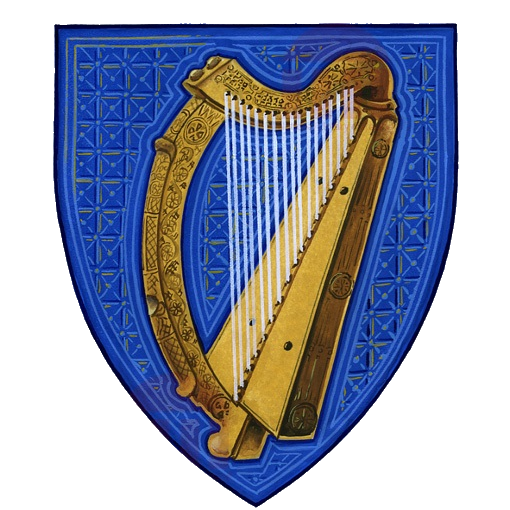Cormeen National School
1841 TO 1968, NEWCASTLE, CO MEATH
by Catherine McCormack
For more information on Cormeen NS reunion check out https://www.facebook.com/pages/Cormeen-School-Reunion-2013/289547587851595
In 1835 a Board of Education was established by the government to standardize education in Ireland. In 1840, Mr Algar gave a site for a new Board of Education National School in the townland of Cormeen. This was to replace Carrigagh and Feagh Hedge Schools and Newcastle Hall School. The school was built in 1840 with funds raised though a collection in Newcastle and grants received from the Board of Education.
A two storied school was built on a site, which is now the entrance lane to Roger’s old house. During renovations on Rogers old house by the current owner a few years back, part of the name plate for this old school was unearthed. The school opened on 2nd February 1841. It was a vested school under the patronage of the Roman Catholic Church. A fire destroyed the old school building and school moved to Newcastle chapel.
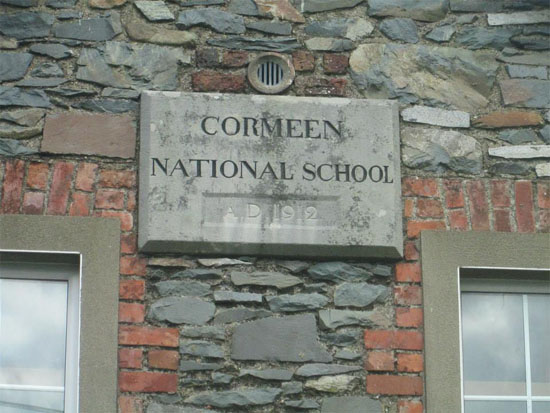
A new school was built in 1912 on a site a few hundred yards towards Newcastle. The stone masons on this building were Wards of Bailieboro. It was a 2 room building with no running water and dry toilets. Under the amalgamation of small schools in the 1960s government program, Cormeen School closed its doors for the last time in June 1968. 27 pupils transferred on 1st July 1968, to St Anne’s National School, Maio, in Golashane townland. The school was auctioned off by Fr Tully, CC Moynalty into private ownership. It changed hands again, and was lovingly restored.
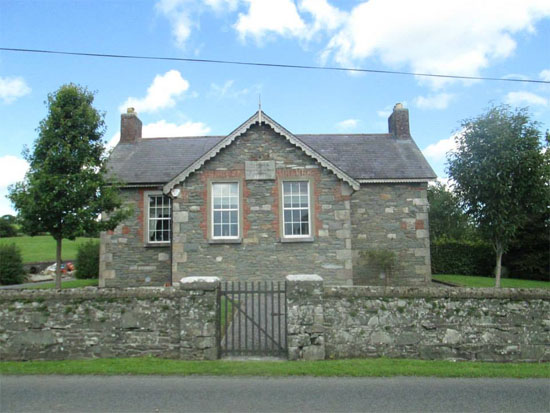
The first principle of the boys school appointed was Master Patrick Rogers, a native of Co Clare. Previously, he taught in the village school, Moynalty. He took digs in Widow Nancy Monaghan’s house in Tullyattin. Master Patrick Rogers retired in 1882 and his son Master Hugh Rogers took over from 1882 to 1913. Master Rynne held the post from 1913 to 1927. Master Bernard Dolan, a native of Co Wexford took over in 1927 until the school’s closure in 1968. He retired from teaching then.
Elizabeth Lynch, Skearke, after completing her teacher training in college, started in Cormeen School in the 1880s, in the girls school. In 1888 Elizabeth Lynch and Hugh Rogers married in Newcastle chapel. Mrs Mary Dolan started teaching in Cormeen in 1927 with her husband. Prior to the school closing, she obtained a teaching post at Edengora National School in Moybologue parish for a number of years until her retirement. Miss Jane Clarke took over till the school closed. Among other teachers who taught at the school were a Mrs O’Brien in the old school and Mrs Nan O’Brien nee O’Reilly Due to numbers, the school became a three teacher school for a time in the 1940s. Miss Nan O’Reilly and her pupils held their lessons in Newcastle Hall. There is no memory of who the girls teacher(s) were before Mrs Elizabeth Rogers.
Subjects taught included the 3Rs, religion, music, the classics, geography, science, and sewing. The school took part in the UCD Folklore collection program in 1937/38. Students submitted local history and folklore in short essays format. They make for interesting reading on microfilm in Navan Library.
Among its past pupils were Bishop Thomas Mulvany, Skearke, Bishop of Meath from 1929 to 1943. He built the Cathedral of Christ the King, Mullingar in the 1930s during the height of a world depression. Master and Mrs Dolan represented Cormeen School at the consecration in Mullingar old cathedral on 30th June 1929. Master Hugh Rogers died a few weeks later on 26th July 1929. Terry Reilly, Skearke, obtained stone mason contracts on Mullingar and Kilmore roman catholic cathedrals during their construction. More of the Reilly tradesmen went to Drogheda and worked on big contracts there.
Monsignor Claude Smith, Newcastle served in the Diocese of Dallas, USA from 1953 to 1997. On the 22nd Nov 1963, Monsignor Smith stood on the corner of Oakdrive and Harwood Street, near Dealey Plaza, the scene of JFK assassination. He saw the presidential motorcade pass. Monsignor Smith did not hear the shots, and only learn of the assassination on his car radio 25 minutes later on his way back to his residence. A front page article of an interview with Monsignor Smith by the Sunday Independent was reprinted in the chronicle edition of 30th Nov 1963. Monsignor Smith had previously met JFK in Dallas in 1960, when he was canvassing for the presidential election.
Miss Maggie Doyle of Leitrim Upper was the mother-in-law of the late Taoiseach Jack Lynch. Senator Patrick J Lynch, Skearke, received his national school education from Cormeen and Killeeter National Schools, higher education at the Model School, Bailieboro and further education in Australia where he qualified as an engineer. He was a prominent politician in Western Australia from 1901 to 1938. Amongst the post he held, were president of the Senate of Western Australia from Aug 1932 to June 1938.
Dan Lynch, Leitrim Lower, was a fluent Irish speaker, gifted Irish musician and dancer, and church sacristan. John Mulvany, Dyrallagh, was a great Irish American painter. He emigrated in 1851 to America at the age of 12 as a stowaway. After a number of years working, he obtained a place in art school in New York. He covered the American Civil War from the battlefields and had access to the most senior generals – Custer, Sheridan and others. Painters then where the forerunners of today’s modern war correspondents. After the civil war, he received further training in Munich, Germany with many other talented artist of his time. Amongst his famous paintings are Custer’s last Rally, 1881 and The Battle of Aughrim, 1885. John Mulvany’s biographer, Thomas P Tuite, in a paper presented in 1909, three years after Mulvany,s death in New York, cites Master [Patrick] Rogers as a great influence on the young Mulvany.
The Dolan children were extremely clever and six of them were conferred with degrees in the arts, engineering and medical fields. James Daly, Cormeen had a “forge” for many years on the main Newcastle road. If James couldn’t mend it, no-one could. Animals were shod, agricultural machinery and household pots and utensils were made or mended. All the news of the day was discussed.
There are plenty of past pupils of the school of the 90 plus mark. Mary “Maude” Smith, Carrigagh, Eileen, Mollie and Aine Smith, Drumaneber, Mary Reilly, Cooks Cross, and Charlie Halton, Carnaville, all appear in the 1929 Cormeen class photos. Others pupils are John Rathborne, Skearke, Dick and Anna Smith, Newcastle. It was with great sadness Newcastle lost it oldest resident and school past pupil, Brigid Gargan nee Halton, during the past year. She was reared and lived all her married life not too far from the school and was a font of local knowledge.
This article was submitted by email dated August 12, 2013 by Catherine McCormack, originally from Druminiskin, Moynalty. A few years ago, Catherine started doing family history and is now looking at her own native area of Maio and Newcastle in the northern end of Moynalty parish. The area shares a long borders with Tierworker parish. Its families have closer links with Tierworker and Relaghbeg than Moynalty. Cormeen NS (National School) in Newcastle held a reunion on 16th Aug 2013.
Edendugally National School
In the 1940s, the children of the McGaurans, McCabes, Farrellys, Reillys, Clarkes, and perhaps a dozen other families living in the townlands to the south of the Loughanleagh Mountain, went to Edendugally National Schoolwhich was built in the years 1838 – 1842. During most of the 1940s, and until the school was closed, there were about 45 pupils – boys and girls – in attendance, with only one teacher, and occasionally two, for 8 classes of children ranging in age from 5 to 14 years.
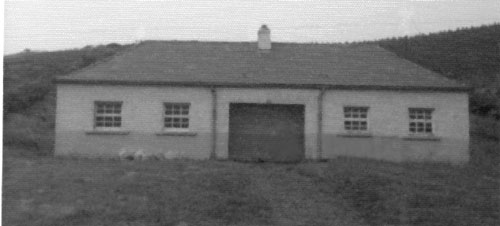
“And many a gambol frolick’d o’er the ground”
Oliver Goldsmith (1728-74) The Deserted Village
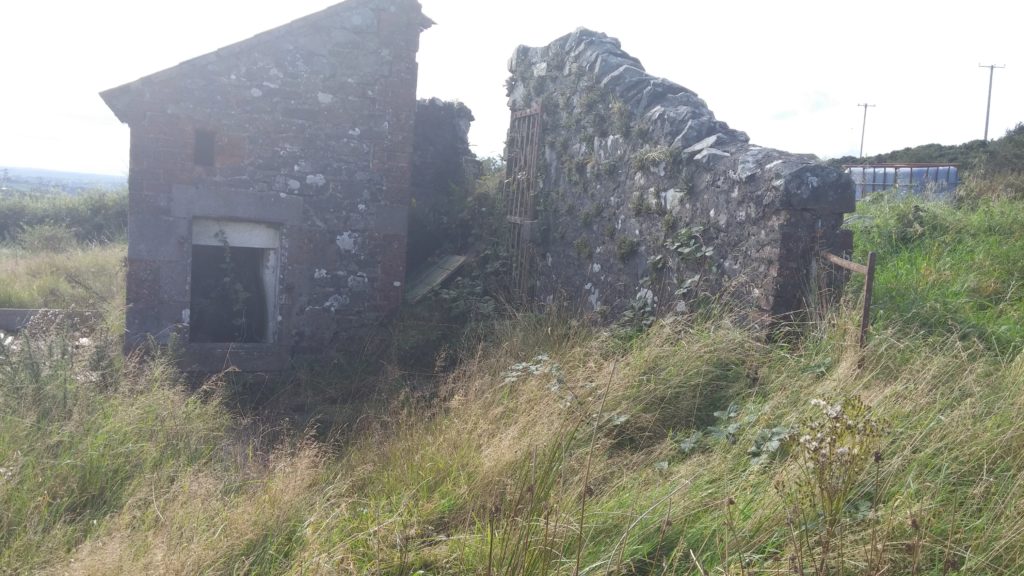
Remains of outdoor toilets (2016)
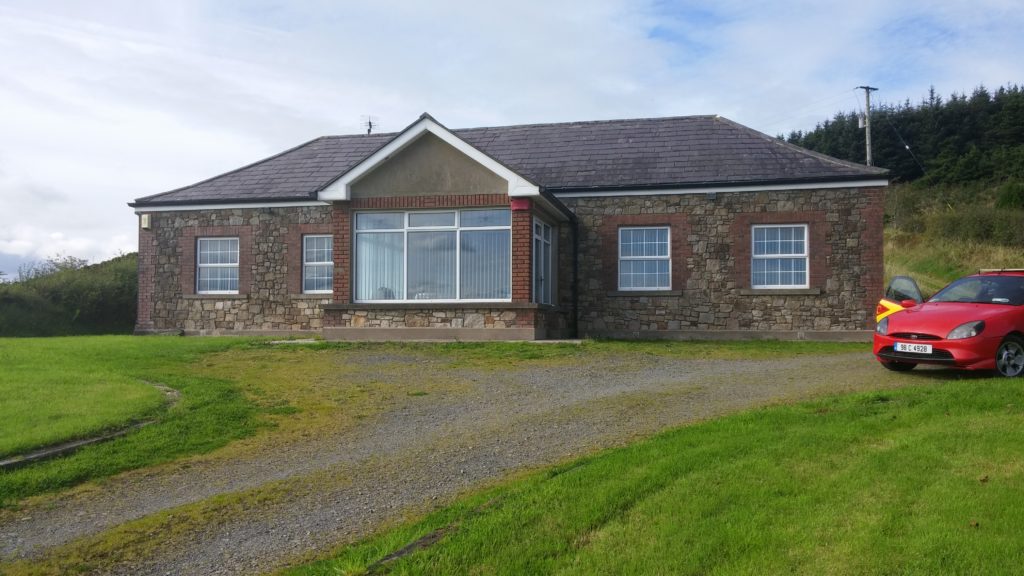
Converted to a residence
The original building stood empty for several years after it ceased to be used as a school in the 1960s, and it has since been modified and converted into a seasonal residence. It had two classrooms, with playgrounds at the front and back of the building.
The front playgrounds were fairly level and those at the back sloped up the side of the mountain. The girls played on the west side and the boys on the east. At the back of the school, the girls’ area was separated from the boys’ by a stone wall which extended from the back of the school up to the outhouses (toilets) at the top of the playground. No toilet paper in these outhouses – a handful of soft grass served the purpose quite well!
Each classroom was heated in winter by burning turf in a range. Every older boy was expected to bring a sod of turf for the fire from home every day. If he forgot, his usual remedy was to steal it from one of the houses along the road on the way to the school. The teacher liked to have fresh water in her classroom each day, and at lunchtime she would send a couple of the big boys down the road to fetch a bucket of water from the well at Phil Tackney’s house. Before entering the school in the morning and after each play period, the teacher blew her whistle and the kids, called scholars, lined up in two rows – boys on the right and girls on the left – at the entrance, with the smallest ones in front and the big boys and girls at the back. While waiting in line to enter, and to pass the time, the girls shouted insults at the boys and, depending on the opportunity, the boys might respond by flipping up the girls’ skirts!
Most of the time, there was only one teacher, Mrs. Daly. She was quite strict and swung her cane with a strong right arm to reinforce learning and discipline. To deal with the wide range of ages, Mrs. Daly used the approach of picking one class for her attention for practically the whole day. She drilled and hammered that class in whatever the subject might be without a let-up, while the rest of the school enjoyed the entertainment and the temporary freedom from persecution – although they were supposed to be working on their assigned exercises. She would sometimes enlist the help of one of the bigger girls to teach or help the other kids. The bigger boys were generally not up to this extra intellectual challenge or responsibility. The subjects taught were reading, writing, and spelling (Irish and English), arithmetic (sums), catechism, sewing, singing, geography.
Mrs. Daly stepped up the pressure during the weeks before the annual visit of the inspector, and the frequent visits by the priest were also a cause for extra stress. The inspector and the parish priest were the teacher’s bosses and she believed in making a good impression. There was no such thing as written reports to parents, but word travelled quickly on how the scholar was doing.
Mrs. Daly was a farmer’s wife whose home was near the town of Mullagh. When she first arrived as the new teacher, replacing Master Boylan, she was about 30 years old; a woman of solid build with black hair combed straight back and cut fairly short up the back of her head with clippers. At first, she came on her bicycle, a fairly strenuous ride of 4 or 5 miles up and down the hills and along rutted roads and lanes, more often in wind and rain than in sunshine. For a while, she used a pony and trap which she parked at Ted McCabe’s house during the day and walked the remainder of the way up to the school. Some time later, she acquired a car – the very first to be seen every day in that part of the country. She now was able to bring her own children with her to the school at Edendugally. We all felt so sorry for them, having their mother as the teacher. It seemed, too, that they got the cane more than the rest of us.
The arrival of Mrs. Daly’s car on the scene was the start of the whole new way of life that was coming rapidly to the country. To travel a distance of three miles by car took about five minutes, compared with at least one hour on foot. With her car, she was now able to take four or five pupils at a time, after school, on a special outing to the town of Bailieborough to see their first movie – The Song of Bernadette, about the apparitions at Lourdes. To the 8 – 10 year olds, this was a new experience as impressive and novel as walking on the moon. She probably paid for all the admission tickets too, because the practice of pestering parents for pennies had not yet been invented, and not every parent had pennies to spend on movies.
During the 1940s, there were other teachers besides Mrs. Daly at Edendugally. For a few years, there was a schoolmistress named Miss O’Connor who taught the 1st, 2nd, and perhaps the 3rd grades, while Master Boylan taught the older children. Miss O’Connor taught us to read and write in English and Irish and our multiplication tables, first in Irish and then in English. Miss O’Connor was generally regarded as very nice and gentle, but the kids thought that she was completely cuckoo. She would talk to herself incessantly in class. During some of these conversations, she would get very excited and might heave a chair or other object across the room to crash into the opposite wall. She always avoided hitting any kids with these missiles, and they took it completely in their stride. Her animated conversations were not confined to the classroom. On the way home, it was normal to see Miss O’Connor standing at the stone wall or hedge along the road while she talked to her invisible audience in the field. Unlike most normal people, she did not need cows, sheep, or goats as conversation partners.
In due course, Miss O’Connor vanished from the scene. Given her special characteristics, she was probably promoted to a big job in the Department of Education in Dublin! The schoolmaster, Mr. Boylan, did not last long either, and, presumably was transferred to another school. For a short while, a young teacher named Miss Duignan succeeded Miss O’Connor and the boys thought she looked really good. There was also a teacher named Miss Duffy for a brief period. When Mrs. Daly arrived, she proved that she would not put up with much nonsense as she wielded her cane energetically in the interests of learning and ruled the roost all alone for several years.
My years at Edendugally began in 1941 at age 6. My mother, Alice, came with me on my first morning and I have no recollection of any problems. Betty, my sister, started 2 years later when she was five and a half. It is probable that Alice came with her too on her first day but I do not remember.
We belonged to the small group of kids that lived to the west of the school. It seemed that the majority approached the school from the direction of Muff to the east. Our walk to the school each morning took us across the fields along the well-trodden cow-track and past the house of Pete and Brian Donnelly (“the Blues”) out to the Bailieborough Road. Here, we might join up with the McGauran boys and young Oga Tully, turn right, and carry on up the road past “the Porra” Donnellys, past Michael Tully’s and Mrs. McMahon’s – where we would be joined by James McMahon – past Phil Tackney’s, up a steep hill past the Coppenagh Road and continue to climb the hill until we reached the gate of the school grounds on the left near the top of the hill. As we approached the Coppenagh Road, we could usually see the McCabes – Teddy and Owney, Peter and Tony – following their path across the fields from Mileady’s to join us by climbing across the stone wall along the road a few hundred feet away from the school.
The journey home was mostly all down hill and there was more time to stop for a while above the Coppenagh Road and look out to the west across the valley of Althy Crim towards our house off in the distance, but not quite visible behind the trees and the high ground of the Fort Field. Before leaving the high ground above the Coppenagh Road, we kept a lookout for stones that were just the right size and shape to set the record for the longest throw across the fields falling off below the road. The McGauran boys were unbeatable where throwing stones was concerned! If the season and the weather were right, we might take a half hour detour across Phil Tackney’s field and go down into Althy Crim – a little wooded valley with big rocks, dark pools, thorny bushes, and trickling streams – to pick hazel nuts. This was a scary place, well known to be the abode of fairies, ghosts and fearful monsters.
Back on the road, we continued home by retracing our steps of the morning. There were never real fights among us on the way to or from school because our ages and sizes were spread out from 6 to 14 but the exchange of insulting names was an acceptable substitute. On the last leg of the trip home, if the sun was shining, we could count on finding either Pete or Brian “the Blue” (Donnelly) sitting on the flat stone near the side of their house. They were friendly, but they had a couple of goats that always looked aggressive in the eyes of little kids, so we usually hurried past there. Both Pete and Brian were in their mid to late 60s and seemed to us to be old men. I have no recollection of ever seeing them do any work – they just sat on that stone.
We were four boys in my class at Edendugally National School. The other three were Teddy McCabe, Brendan Reilly, and Paddy McCabe. The two McCabes were from different families and probably not closely related. Mrs. Daly gave us a good share of her scarce time. We did not enjoy those days when we stood in front of her as she honed our skills in mental arithmetic and spelling. I was usually able to survive these sessions with only minor collateral damage but the others did not always escape as much of her wrath. Brendan Reilly was quick-witted and smart, and he went on in later life to become a leading local businessman. However, he did not benefit from “the halo effect”, so Mrs. Daly gave him very little slack and he took more than his share of punishment. No matter how sore our hands were, we never shed a tear.
I finished the 5th grade at Edendugally in 1947 and Betty had completed 3rd. Our father wanted to give us better opportunities for education and in that year he sold the farm in Greaghnadarragh. We moved to Skryne (also spelled Skreen), about six miles south of Navan in Co. Meath and attended Skryne National School. This was a whole different world. This school was new. It had four classrooms and four teachers. The school population was probably well over one hundred. There was running water, electric light, and indoor toilets. The blackboards were green and were mounted on the walls. There were roofed wings attached to the building to provide shelter from the rain during lunch breaks. I spent only one year at Skryne to complete the 6th Grade and the National School Leaving Certificate. I was then able to go to St. Patrick’s Classical School in Navan in 1948 for secondary education, thanks to the fees paid by my father. Betty completed her national school years at Skryne and then went to secondary school at the Loreto Convent, also a private school, in Navan.
The time was approaching in the late 1940s when big changes would come for small country schools such as Edendugally. Most were about to be closed and replaced by a more centralized system of larger modern buildings with electricity, indoor plumbing, and other amenities.
Edendugally was one of the first generation of schools built after the National Education System was established in 1831 by Lord Edwin Stanley, the British Government’s Lord Lieutenant of Ireland. These schools were non-denominational and state-run. Not surprisingly, these proposals for education of the masses gave rise to considerable controversy. Roman Catholics were against mixing Catholic and Protestant pupils and the Protestant Church of Ireland wanted a controlling role in national education. In the early years of the nineteenth century there was no shortage of schools in Ireland, but many were in a poor state of repair and badly conducted. In 1832 it was estimated that there were in existence around 9,000 schools requiring payment of fees, and over 2,000 other elementary schools.
The national schools were built with funds raised by local trustees and supplemented by government grants from the Commissioners of National Education. The community was responsible for providing the site for the new school which was then vested in trustees who were frequently landlords, local clergymen, or other leaders in the community. Patronage was normally vested in the local bishop of the diocese who appointed a manager, typically a minister or parish priest, with virtually full control over hiring and firing and, as a general rule, employed teachers of his own denomination.

In retrospect, and from the vantage of big-city life as it has evolved at the beginning of the 21st century, it was a great privilege to have been part of the last generation to pass through what, today, would be called the primitive school system launched by the British Administration in Ireland in 1831. It seems fitting that one of these schools was anchored on the side of the Loughanleagh Mountain, and although it no longer looks out on a sunny morning in April, or on a cold and rainy afternoon in January, over a playground full of barefoot boys and girls, the building still stands as solid on its foundations as it was on the night of January 6, 1839 – The Night of the Big Wind. That great wind storm huffed and puffed at the thick stonewalls of the newly constructed building but all it succeeded in doing was to blow off some of the heavy Blue Bangor slates from the roof. The memory of that fearful night still lives on to this day in the stories told by the people in the surrounding townlands.
The school has been closed for more than a few decades. The countryside that it once served has become home to less than a dozen children who probably travel in a school-bus to a town several miles away. There is practically no cultivation of the fields – no golden patches of ripening oats in August, and no smell of freshly cut hay drying in the July sun. The cattle now have the fields to themselves and they can graze peacefully on the green grass without being disturbed by bare-foot stone-throwing boys on their way home from school. Electrical power lines are strung high over valleys and hills, nobody cuts turf for the kitchen fire, and no tired mother carries water home in a bucket from the well to make the evening tea.
Trees of the conifer variety have been planted over much of the surface area of the Loughanleagh Mountain, leaving little space for the bilberry plants and the purple flowered heather. Telecommunication masts and their anchor wires occupy the highest point of the mountain, close to the site of a prehistoric cairn and presumed burial site of some predecessor inhabitants. Proposals to decorate the mountain with still more telecommunications masts attracted waves of protest from all the usual suspects who, for several years, maintained a protest camp, housed in a trailer not far from the old school-house, to keep the protesters in comfort as they perform their jobs.
The following is a reproduction of a letter to the Editor of the Meath Chronicle dated 23 March 2002:
Loughanlea Heritage must be preserved.
Loughanlea is a unique heritage treasure and local protest at its violation is fully justified. It is shocking to learn that concrete bases of masts have encroached on the prehistoric burial cairns there. In addition to its precious archaeological monuments, Loughanlea is a site of rich natural habitat, unique in the region, and merits careful conservation rather than the present abuse.
Loughanlea is also strikingly important as a seat of age old Lughnasa traditions, still evident today in the Bilberry Festival and the ancient fair of Muff. The Celtic harvest god was Lugh, hence Lughnasa, the Irish August, and Brian Friel’s famous work, Dancing at Lughnasa. When the harvest ripened, our ancestors climbed high places such as Loughanlea to thank Lugh, offering first fruits of the grain. In return Lugh granted them the purple bilberries, the first fruit of the harvest season. Later, the potato became the staple of diet. Thus on Bilberry Sunday the first potatoes were ritually eaten. The day was called Colcannon Sunday: the dish was known as colcannon, poundy and cally.
The Lughnasa mythology and folklore of Loughanlea are firmly rooted in our pre-historic past. This site is the focus of age old rites and customs, intimately anchored in Irish life, which bind people to place with religious intensity.
The Bilberry Committee in Bailieboro and the people of the area generally, rightly cherish the Loughanlea heritage. Cavan County Council should support them financially in enhancing that heritage and should make Loughanlea a Special Policy Area. Loughanlea must also be designated by Duchas as a Natural Heritage Area. Urgent official action is now imperative. People are entitled to their roots.
Seamus MacGabhann,
National University of Ireland, Maynooth, Co. Kildare
The sentiment that I attach to the old school-house and the motivations of the protesters is well captured by Seamus MacGabhann’s letter which does a good job of drawing attention to the many different cycles of life that encircle a particular feature of a landscape like the growth rings of a tree. The individual rings merge almost seamlessly into thicker and undifferentiated bands, so that their unique colour and individual character are lost in the passing of the years.
At the crossroads just a couple of miles away, on the 12th of August every year, some of the ancient rituals of the Horse Fair of Muff are still carried on. It is safe to say, however, that the horses offered for sale at the fair have never pulled a plough or dragged a cock of hay in from the field. They, like their owners, arrived at the Fair by motor vehicle. Nobody, except perhaps the odd eccentric, walks along the road that passes by what was once the Edendugally school-house, and, with every succeeding year the memories of another way of life fade out of existence.
[1] Many spelling variations exist. For example, maps based on the Ordnance Surveys use the spelling ‘Edennagully’
[2] An abridged version of this article was published in The Anglo-Celt (a Cavan newspaper) on August 5, 2004.
[3] The Deserted Village, Oliver Goldsmith (1728-1774)
